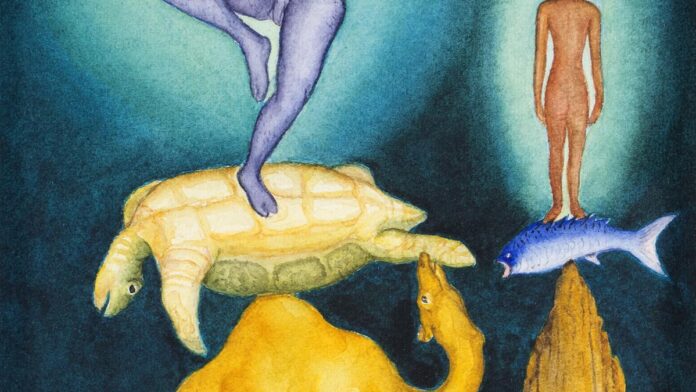
Kaliyug by Dilip Ranade, one of the artworks at the exhibition
| Photo Credit: Special Arrangement
From time to time, the world faces the wrath of nature when diseases break out. It makes human beings realise how intrinsically the ecosystem is linked to our existence. When we disturb the ecosystem, nature fights back.
“In all the years of our existence, we have wiped out almost a third of all species that ever lived”, says Ritika Kochar, art writer and author.
From the three-headed hound in Greek mythology to Lord Rama’s army of monkeys in the Ramayana, mythological stories from all over the world mention animals and the integral roles they played in human existence.
A collection of 25 works by eight artists, on display at the Threshold Gallery, highlights the inter-relatedness of animals with our domestic lives. The exhibition attempts to relook the divine power attributed to flora and fauna.
Gulammohammed Sheikh beautifully recreates the story of Laila and Majnu, showing the Simurgh and other birds lamenting their death. V. Ramesh’s watercolour on canvas recreates the Dasavatar of Vishnu in Pahari miniature style.
Anindita Bhattacharya’s story of how the elephant Gajananda becomes a devotee of Lord Vishnu is very similar to the Jataka tales. A suite of 48 works, it is a deeply philosophical series that looks at forming a new mythology around a single animal.
Avishek Sen, one of the participating artists, says: “Once upon a time, animals like snakes were seen near human settlements. Now, we are creating sanctuaries for them to prevent them from disappearing. But they are made to live in isolation and are no longer included in our living styles as it was in earlier times. I have created my own illusionary world with these reptiles,” he says.
Curated by Tunty Chauhan, the exhibition revels in the divine power attributed to animals and how intrinsically they are linked to our lives. “Myths often have cosmogonic overtones often connected with rituals of any culture. Secular and sacred myths co-exist and reflect a social order or values”, says Tunty.
Myths are also mutable in nature – they vary with time and geographies. The way the Ramayana is narrated in North India is very different from how it is narrated in South India. Our understanding of a myth depends on our own evolution, she adds.
Myths are like metaphors, narratives and histories of a sacred nature, often connected with rituals within any given culture. They are stories of the search by men and women through the ages for meaning, for significance, to touch the eternal, to understand the mysterious, and to find out who we are, says Ritika
The artists have explored how myths have been interpreted and reimagined over time. A conversation on the animals that are worshipped in our society have been visualised in different forms of indigenous and contemporary art.
(At Threshold Art Gallery , C -221 Sarvodaya Enclave; Till April 15; 11 am to 8 pm)
#Artists #paint #relevance #animals #lives
